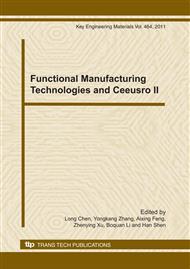p.514
p.518
p.524
p.528
p.532
p.537
p.542
p.548
p.552
Investigation of Laser Shock Processing on the Key Weld Zone of Offshore Platform
Abstract:
Effects of laser power and spot diameter on residual stress and micro-hardness of the welding of ship plate (ASTM A 131) by laser shock processing (LSP) has been investigated. While laser power is 45.9J, spot diameter less thanφ3 mm, the distribution of residual stress in welding line occurs obvious variation, which residual stress compressive increase obviously with spot diameter decrease. When power density is bigger than 1.2×1010 W/cm2, the surface residual stresses and micro-hardness of the welded specimen occur change by LSP. The results show that mechanical properties of the welded joints will be improved by LSP. Laser shock processing produced a residual compressive stress layer on the surface of the target, which is an effective method for protecting the welded steel structures against stress corrosion.
Info:
Periodical:
Pages:
532-536
Citation:
Online since:
January 2011
Authors:
Price:
Сopyright:
© 2011 Trans Tech Publications Ltd. All Rights Reserved
Share:
Citation:


